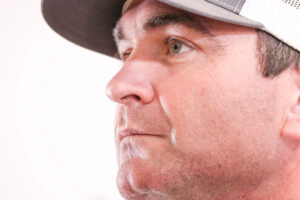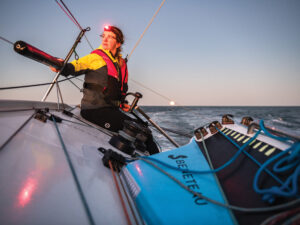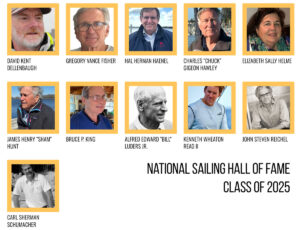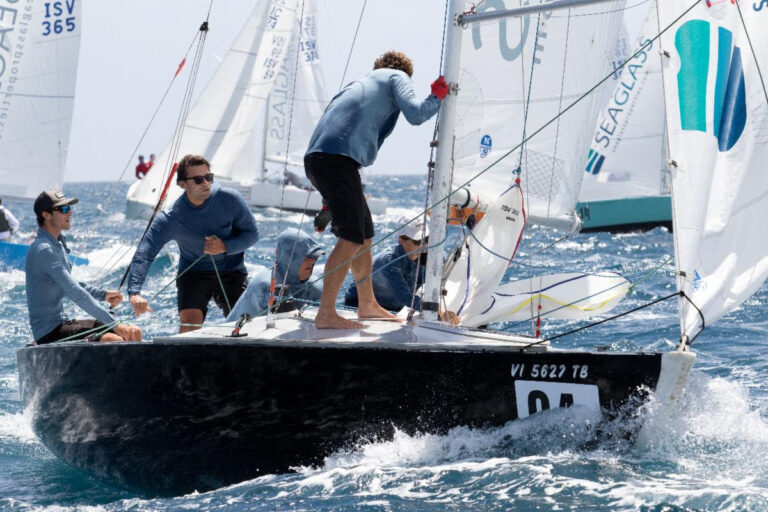The Rolex Transatlantic Challenge proved to be quite a race between the new Greg Elliott-designed 100-foot canting keel, wing masted Maximus and the 142-foot Mari Cha IV. With a low pressure system rolling up the U.S. East Coast the weather routing gave us a couple of options. We could either head south and sail around the bottom of the low and have moderate tailwinds or go straight at the mark and end up with strong headwinds and big waves-a no brainer, it seemed to us. Both Maximus and Mari Cha headed south while Carrera took a more northerly route and, while leading on distance to the finish for a time, paid the price, breaking down once the bad conditions hit. Over the first few days the lead swapped back and forth between Maximus and Mari Cha as light and variable conditions prevailed, but as the low rolled by and the wind freed it was time to start heading north. By this point the wind had built to around 30 knots and Mari Cha had a 20-mile lead over Maximus as she had broken north a few hours earlier. On Maximus we were gennaker reaching at around 20 to 28 knots. The wind was starting to head us further and continued to build, so it was time to drop the gennaker and get a jib top up, also a much easier combination for the night ahead. This was where we had our fist technical hitch. The canting keel electronics can be operated by buttons on deck, and when we went to center the keel a bit to stop the boat heeling way over to windward when we spiked off the gennaker we discovered that water had gotten into the buttons. Instead of moving the keel halfway back toward the center the keel swung all the way to the leeward side, 55 degrees of cant the wrong way, gennaker still up! We had an interesting time stopping the big broach. After about an hour or so we managed to get the gennaker down and jib top up and bring the boat back on course. The waves had built, the wind was gusting to 40 knots, and Maximus was surfing down waves at over 30 knots. When the next position report came in we found that Mari Cha had also had problems and we had closed to within 5 miles. By the following afternoon, when the wind moderated and the seas flattened to nice upwind sailing, we had jumped out to a 40-mile lead. We were now about four days into the race and heading for the Grand Banks. Overall, progress had been slow. We had yet to actually point the boat toward the finish line and were still not able to. A coupe of days in moderate upwind conditions did allow us to so some experimentation with different amounts of trim tab on the canard and degrees of mast rotation. But progress was still slow; our GPS told us we’d be arriving about the 8th June, some 18 days after the start. However, our weather-routing program was consistent with an 81/2-day race, so we only had about four days still to travel, with 2,000 of the 3,000 miles still to go. The latter part of the trip promised some nice fast reaching, but we still had one more nasty front to get through. We were still about 30 miles ahead of Mari Cha. Thus far Maximus had held together well. Maximus had done little sailing before this race, arriving late for Antigua Race Week, so many of the systems were still untested. Our bow men spent a lot of time up the rig attaching strops and safetys to hold sails up if the halyard locks failed, and we had one guy full time keeping all the systems working properly-these yachts have hydraulics everywhere. As we approached the front that we needed to get through to get to the reaching conditions on the other side we felt we were in pretty good shape. Mari Cha had tacked to go through the front about six hours earlier and we had stretched out to some 50 miles. If we could get through the front reasonably quickly we should be in good shape to hold her off for the remainder of the race to England. But, as usual, our weather routing predicted 30-knot winds and we had 40 knots. The sea state was nasty, very short waves with no backs, and to make things worse it seemed that we had also got back into some Gulf Stream current. It wasn’t long before the headboard carriage decided that it didn’t like this at all and parted company with the head of the mainsail. Now if we had a spare this would have been a quick fix, but we didn’t, so it was mainsail down for the night while the car was drilled and tapped and the head of the mainsail lashed to the car. The wave state grew worse and we sailed Maximus at around 8 knots through the night to try to avoid major crashing off waves. Sometime during the night, while launching off a particularly large wave, the wind gear parted company with the top of the mast, depriving us of wind data for the rest of the race. By morning the wind abated and the front had passed. We set the mainsail and off we went, finally heading towards England, but now 18 miles behind Mari Cha, and losing hourly as she enjoyed more wind. From here on in it was fast reaching, averaging around 18 knots in about 20 knots of wind. The miles rattled off quickly. Given the same reaching conditions we were able to hold onto Mari Cha, which was surprising. We stayed 33 miles behind her all the way to the corner of England and ended up finishing four hours after her at the Needles, off Southampton. A good result, as she owed us some 14 hours on time!









